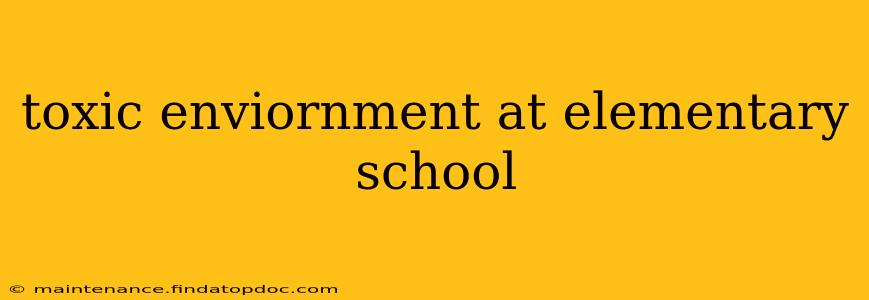A toxic environment at an elementary school can have devastating consequences for children's emotional, social, and academic development. It's crucial for parents, teachers, and administrators to recognize the signs and take proactive steps to create a safe and nurturing learning environment. This article will delve into the complexities of a toxic elementary school environment, exploring its various manifestations and offering practical solutions.
What are the signs of a toxic elementary school environment?
Identifying a toxic environment isn't always straightforward. It can manifest in subtle ways or be overtly obvious. Key indicators can include:
- High levels of bullying and aggression: Persistent physical, verbal, or emotional bullying, with insufficient intervention from staff.
- Lack of teacher support and collaboration: Teachers feeling unsupported, overworked, and unable to collaborate effectively, leading to burnout and impacting student learning.
- Negative school culture: A pervasive climate of fear, anxiety, or negativity amongst students and staff.
- Ineffective leadership: Poor communication, lack of transparency, and a failure to address concerns from parents and staff.
- High teacher turnover: Frequent changes in teachers can disrupt student learning and contribute to instability.
- Lack of resources and support: Insufficient funding, inadequate classroom materials, and limited access to essential services like counseling.
- Unrealistic expectations and pressure: Excessive academic pressure on young children can lead to stress and anxiety.
- Discrimination and harassment: Any form of bias or prejudice directed towards students or staff based on race, religion, gender, sexual orientation, or disability.
- Poor communication between school and parents: A lack of transparency and consistent communication can create distrust and hinder problem-solving.
How can I tell if my child is affected by a toxic school environment?
Children often don't explicitly articulate their negative experiences at school. However, there are subtle signs parents should watch for:
- Changes in behavior: Increased anxiety, withdrawal, aggression, or changes in sleeping or eating patterns.
- Physical complaints: Unexplained headaches, stomach aches, or other physical ailments.
- Reluctance to go to school: Persistent complaints about school, refusal to attend, or excessive tardiness.
- Decreased academic performance: A drop in grades or a lack of engagement in schoolwork.
- Changes in social interactions: Withdrawal from friends, difficulty making friends, or reports of being bullied or excluded.
What are the long-term effects of a toxic elementary school environment?
A toxic elementary school environment can have significant long-term consequences, including:
- Mental health issues: Increased risk of anxiety, depression, and other mental health disorders.
- Academic struggles: Lower academic achievement and decreased motivation to learn.
- Social and emotional difficulties: Difficulties forming healthy relationships, low self-esteem, and increased social isolation.
- Physical health problems: Increased susceptibility to stress-related illnesses.
What can parents do if they suspect a toxic environment at their child's school?
If you suspect a toxic environment at your child's school, it's crucial to take action:
- Document incidents: Keep a detailed record of any incidents or concerns.
- Communicate with the school: Contact the teacher, principal, or school counselor to express your concerns.
- Seek support: Connect with other parents, community organizations, or mental health professionals.
- Consider alternative options: If the situation doesn't improve, consider transferring your child to another school.
How can schools create a positive and supportive environment?
Creating a positive school environment requires a multifaceted approach:
- Invest in teacher training and support: Provide teachers with the resources and training they need to effectively manage their classrooms and support their students.
- Implement effective anti-bullying programs: Develop and implement comprehensive anti-bullying policies and programs.
- Foster a culture of respect and inclusion: Promote a school culture that values diversity and inclusivity.
- Improve communication and collaboration: Enhance communication between teachers, parents, and administrators.
- Prioritize student well-being: Provide students with access to mental health services and other support programs.
Addressing a toxic elementary school environment requires a collaborative effort from parents, teachers, administrators, and the wider community. By working together, we can create safe, supportive, and nurturing learning environments where all children can thrive.
